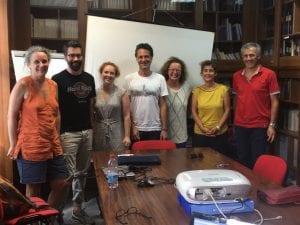Using Fault data in seismic hazard and risk assessment: A fault2SHA initiative
By Joanna P Faure Walker, on 22 March 2021
Effective fault data presentation helps make progress in the calculation of earthquake hazard and risk.
Cross-disciplinary working can help progress. For calculating seismic hazard, the Fault2SHA Working Group has brought together data providers, modellers and seismic hazard and risk practitioners to help promote the use of fault data in seismic hazard assessment… Fault2SHA representing fault – to – seismic hazard assessment.
In the case of earthquake hazard and risk calculations, a key barrier to fault-based seismic hazard assessment has been the availability of data in a format that can be easily incorporated into calculations of hazard and risk. This has hindered efforts to provide long-term views of hazard and risk. Long-term, multi-millennia time frames cover several seismic cycles such that the long-term behaviour of faults can be identified and not miss out faults capable of hosting earthquakes which have not ruptured within a short-term observation periods (tens or hundreds of years). A further restriction has been the difficulty for modellers to interrogate the detail and uncertainties in primary data. To address these issues, the Fault2SHA Central Apennines laboratory, led by Dr Joanna Faure Walker (UCL IRDR), has created a database structure demonstrating a usable format by which geologists can present data that can be directly incorporated into hazard and risk calculations. To demonstrate its effectiveness, the laboratory has tested the database to calculate simplified calculations of risk in the Central Apennines and demonstrated the effectiveness, even at a simple level, for identifying which faults threaten the public the most and where additional data would have the most impact on current calculations. It is hoped those working in other regions can help the endeavour of promoting the use of faults in seismic hazard assessment through adopting a similar approach.
This work brings together researchers from different research groups in the UK, Italy and France: Joanna Faure Walker, Paolo Boncio, Bruno Pace, Gerald Roberts, Lucilla Benedetti, Oona Scotti, Francesco Visini, and Laura Peruzza
The two papers are published Scientific Data and Frontiers in Earth Science, while the database is available through PANGAEA.
Fault2SHA Central Apennines Database and structuring active fault data for seismic hazard assessment
Fault2SHA Central Apennines Database
The Fault2SHA working group runs a monthly online learning series to help cross-disciplinary working and annual workshops. The learning series and 2020 workshop is available through the Fault2SHA youtube channel. A summary of the database is provided by Joanna at 17 mins into the first session of the Fault2SHA 5th workshop:Promoting Faults in Seismic Hazard Assessment
 Close
Close




